 W
WThe Allegory of Isabella d'Este's Coronation is a painting by the Italian Renaissance painter Lorenzo Costa the Elder, dating to about 1505–1506. It is displayed in the Louvre Museum of Paris, France.
 W
WAscent of the Blessed is a Hieronymus Bosch painting made between 1505 and 1515.
 W
WThe Bagnacavallo Madonna is an oil painting by Albrecht Dürer, dating to before 1505. It is now in the Magnani-Rocca Foundation of Traversetolo, in the province of Parma, Italy.
 W
WThe Biddende Maria is an oil on panel painting by the Flemish renaissance artist Quentin Matsys. The painting was produced in the first decade of the 16th century, probably in 1500. The painting is currently housed at the Royal Museum of Fine Arts in Antwerp. The panel is the interior of the left wing of a diptych with the painting on the other side being a Salvator Mundi.
 W
WThe Calendar Clock Face is an unusual painting from c.1500 by an unknown painter in the collection of the M - Museum Leuven. The moveable parts and all polychromy has been removed in the course of centuries.
 W
WThe Madonna and Child Between St. Francis and St. Nicasius, also known as Castelfranco Madonna, is a painting by the Italian Renaissance artist Giorgione executed around 1504. It remains in the equivalent of its original setting, in a side-chapel of the Cathedral of Castelfranco Veneto, Giorgione's native city, in Veneto, northern Italy, although the present church dates to the 18th century.
 W
WThe Conestabile Madonna is a small painting by the Italian Renaissance artist Raphael. It was likely the last work painted by Raphael in Umbria before moving to Florence.
 W
WEcce Homo is a subject of a series of oil on panel paintings by Andrea Solari, dating to between 1505 and 1510. Its hands show the influence of Solari's master Leonardo da Vinci and particularly his Lady with an Ermine.
 W
WEcce Homo is a painting by the Renaissance painter Andrea Mantegna. It is conserved at Musée Jacquemart-André in Paris. It depicts the presentation of Jesus Christ crowned with thorns.
 W
WThe Ecce Homo and Mater Dolorosa Diptych consisted of two small oil-on-panel paintings usually attributed to the Early Netherlandish artist Aelbrecht Bouts produced between 1491 – 1520. For many years they formed the wings of a hinged devotional diptych, but are now broken apart. Although their exact dating is unknown, the Ecce Homo panel, portraying Jesus bound and crowned with thorns, is thought to have been painted after 1491, while the Mater Dolorosa panel presents the Virgin Mary as Our Lady of Sorrows, and was painted after 1517. Both panels measure 45.5 x 31 cm, although the Mater Dolorosa is slightly larger at 31.1 cm wide. They are in the collection of the Suermondt-Ludwig-Museum, Aachen, Germany, where they are hung alongside each other.
 W
WThe Entombment is an unfinished oil on wood panel painting of the placing of the body of Jesus in the garden tomb, now generally attributed to the Italian Renaissance master Michelangelo Buonarroti and dated to around 1500 or 1501. It is in the National Gallery in London, which purchased the work in 1868 from Robert Macpherson, a Scottish photographer resident in Rome who, according to various conflicting accounts, had acquired the painting there some 20 years before. It is one of a handful of paintings that are attributed to Michelangelo, alongside the Manchester Madonna, the Doni Tondo, and possibly the The Torment of Saint Anthony.
 W
WThe Heller Altarpiece was an oil on panel triptych by German Renaissance artists Albrecht Dürer and Matthias Grünewald, executed between 1507 and 1509. The artwork was named after Jakob Heller, who ordered it. Dürer painted the interior, Grünewald the exterior.
 W
WThe Jabach Altarpiece is an oil on lime tree panel painting by German Renaissance artist Albrecht Dürer, executed around 1503–1504. Originally a triptych, only the side panels are now preserved: the right picture, measuring 96×54 cm, is housed in the Wallraf-Richartz Museum of Cologne; the left picture, measuring 96×51 cm, is housed in the Städel of Frankfurt.
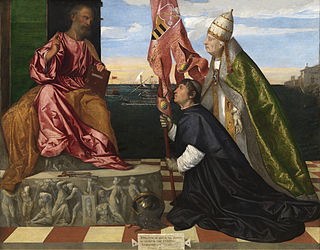 W
WJacopo Pesaro being presented by Pope Alexander VI to Saint Peter is an oil painting on canvas by Titian, now in the Royal Museum of Fine Arts in Antwerp.
 W
WThe Judgment of Paris is a 1528 painting by the German artist Lucas Cranach the Elder. It depicts the myth of Paris, Prince of Troy, selecting the fairest goddess from among Minerva, Juno, and Venus. Cranach likely based his depiction on medieval poetry or romances. The painting is now in the Metropolitan Museum of Art, New York.
 W
WThe Judgment of Solomon is a painting by the Italian Renaissance master Giorgione of the Judgement of Solomon created c. 1502-1505. It is housed in the Galleria degli Uffizi of Florence.
 W
WJudith is a painting by the Italian painter Giorgione, executed around 1504. It is one of the few authentic works by Giorgione owned by the Russian Hermitage Museum. The painting, originally attributed to Raphael, came to the Hermitage in 1772 from Paris. Like many other paintings, it refers to the Judith and Holofernes motif.
 W
WThe Last Judgment is a triptych created by a follower of Hieronymus Bosch. Unlike the other two triptychs with the same name, in Vienna and in Bruges, only a fragment of this one exists today. It resides at the Alte Pinakothek in Munich.
 W
WThe Line of Saint Anne is a c.1500 oil on panel painting by Gerard David, now in the Museum of Fine Arts of Lyon, which acquired it in 1896. It shows the ancestors of saint Anne, mother of the Virgin Mary, along the lines of a Tree of Jesse.
 W
WThe Lucan portrait of Leonardo da Vinci is a late 15th- or early 16th-century portrait of a man that was discovered in 2008 in a cupboard of a private house in Italy. It strongly resembles a portrait of Leonardo da Vinci by Cristofano dell'Altissimo held by the Uffizi Gallery. The painting was previously thought by its owners to represent Galileo but on its discovery a claim was made that it is a self-portrait by Leonardo da Vinci. Alessandro Vezzosi, director of the Museo Ideale Leonardo da Vinci at Vinci said in 2011 that he had excluded the possibility that it was a self-portrait, but that the painting "remains intriguing because it adds a new element to the Leonardo puzzle".
 W
WThe Madonna del cardellino or Madonna of the Goldfinch is a painting by the Italian Renaissance artist Raphael, from c. 1505–1506. A 10-year restoration process was completed in 2008, after which the painting was returned to its home at the Uffizi in Florence. During the restoration, an antique copy replaced the painting in the gallery.
 W
WThe Madonna in Glory with Saints is a painting by the Italian Renaissance painter Pietro Perugino, dating to c. 1500–1501. It is housed in the Pinacoteca Nazionale of Bologna, Italy.
 W
WThe Madonna of the Pinks is an early devotional painting usually attributed to Italian Renaissance master Raphael. It is painted in oils on fruitwood and now hangs in the National Gallery, London.
 W
WMadonna of the Towers is a painting in tempera on panel of c. 1505–1519 by Bramantino, produced after his return from Rome. Previously in the church of San Michele alla Chiusa in Milan, in 1872 it was donated by Lodovico Melzi d'Eril to the Pinacoteca Ambrosiana in the same city, where it still hangs.
 W
WMary Magdalene is an oil on panel painting of Mary Magdalene, dating to around 1500 and now in the Galleria Palatina in Florence - it has featured in its inventory since 1641. It is now attributed to Perugino. It is modelled on his wife Chiara Fancelli, who also modelled for several of his Madonnas. It is comparable to his Madonna and Child with St John the Baptist and St Catherine of Alexandria (Louvre), of similar date and with a similar dark background.
 W
WThe Mocking of Christ is an early oil on wood painting (1503–1505) by Matthias Grünewald. It is located today in the Alte Pinakothek, Munich.
 W
WThe Mona Lisa is a half-length portrait painting by Leonardo da Vinci. Considered an archetypal masterpiece of the Italian Renaissance, it has been described as "the best known, the most visited, the most written about, the most sung about, the most parodied work of art in the world". The painting's novel qualities include the subject's enigmatic expression, the monumentality of the composition, the subtle modelling of forms, and the atmospheric illusionism.
 W
WThe Montini Altarpiece is an oil on canvas painting by the Italian Renaissance artist Cima da Conegliano, dating from around 1506-1507 and housed in the Galleria Nazionale of Parma, Italy.
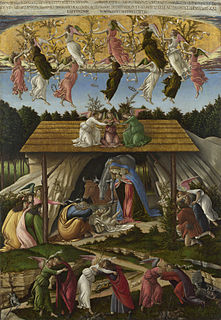 W
WThe Mystical Nativity is a painting dated c. 1500–1501 by the Italian Renaissance master Sandro Botticelli, in the National Gallery in London. Botticelli built up the image using oil on canvas. It is his only signed work and has an unusual iconography for a painting of the Nativity.
 W
WThe Oddi Altarpiece is an altarpiece of the Coronation of the Virgin painted in 1502-1504 by the Italian Renaissance master Raphael for the altar of the Oddi family chapel in the church of San Francesco al Prato in Perugia, Italy, now in the Vatican Pinacoteca. The altarpiece was commissioned for the Oddi family chapel in San Francesco al Prato in Perugia, was taken to Paris in 1797 and with 1815 brought back to Italy, not to Perugia but to the Vatican Pinacoteca.
 W
WThe Sant'Agostino Altarpiece is a painting by Perugino, produced in two stages between around 1502 and 1512 and then around 1513 to 1523. The altarpiece's 28, 29 or 30 panels were split up during the Napoleonic suppression of religious houses - most of its panels are now in the Galleria Nazionale dell'Umbria in Perugia. It is notable as the painter's last masterwork before he moved into his late phase producing more provincial commissions.
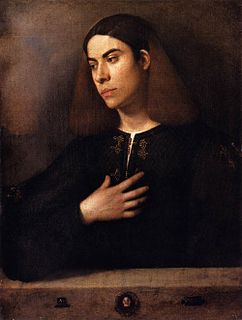 W
WPortrait of a Young Man or Portrait of a Youth is a c.1508-1510 painting, attributed to Giorgione and now in the Museum of Fine Arts in Budapest. Some have instead attributed it to Giorgione's collaborator Giovanni Cariani.
 W
WThe Portrait of a Young Woman, also known as La Muta, is a portrait by the Italian Renaissance artist Raphael, c. 1507–1508. It is housed in the Galleria Nazionale delle Marche, in Urbino.
 W
WThe Portrait of Agnolo Doni is an oil painting by Italian Renaissance master Raphael, executed between 1506 and 1507. It is now in the Pitti Palace in Florence.
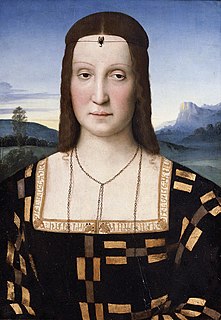 W
WThe Portrait of Elisabetta Gonzaga is a painting from around 1504, attributed to the Italian Renaissance artist Raphael and housed in the Uffizi Gallery, Florence.
 W
WThe Portrait of Emilia Pia da Montefeltro is a picture from around 1504–1505, attributed by some to the Italian Renaissance artist Raphael and housed by the Baltimore Museum of Art, United States
 W
WRest on the Flight into Egypt is a 1501-1520 oil on panel painting by Gerard David, probably originally commissioned for the Convent of Our Lady of Paradise in Évora and now in the Museu Nacional de Arte Antiga in Libson.
 W
WThe Resurrection of Christ (1499–1502), also called The Kinnaird Resurrection, is an oil painting on wood by the Italian High Renaissance master Raphael. The work is one of the earliest known paintings by the artist, executed between 1499 and 1502. It is probably a piece of an unknown predella, though it has been suggested that the painting could be one of the remaining works of the Baronci altarpiece, Raphael's first recorded commission. The painting is now in the São Paulo Museum of Art.
 W
WSalvator Mundi is a painting by Italian Renaissance artist Leonardo da Vinci dated to c. 1500. Long thought to be a copy of a lost original veiled with overpainting, it was rediscovered, restored, and included in a major Leonardo exhibition at the National Gallery, London, in 2011–12. Christie's claimed just after selling the work that most leading scholars consider it to be an original work by Leonardo, but this attribution has been disputed by other specialists, some of whom posit that he only contributed certain elements.
 W
WSanta Cristina al Tiverone Altarpiece is a painting by the Italian Renaissance painter Lorenzo Lotto, executed around 1504–1506. It is still housed in its original location, the parish church of Santa Cristina in Quinto di Treviso, a frazione of Treviso, northern Italy.
 W
WThe Self-portrait is commonly dated between 1504 and 1506. It measures 47.5 cm by 33 cm. The portrait was noted in an inventory of the private collection of Duke Leopoldo de' Medici, completed in 1675, and later listed in the 1890 Uffizi inventory.
 W
WThe Seven Sorrows Polyptych is an oil on panel painting by Albrecht Dürer. The painting includes a central picture, currently at the Alte Pinakothek in Munich, and seven surrounding panels which are exhibited at the Gemäldegalerie Alte Meister of Dresden.
 W
WThe Solly Madonna by the Italian renaissance artist Raphael was painted sometime between 1500 and 1504.
 W
WSt. Sebastian is a painting of early Christian saint and martyr Saint Sebastian by the Italian High Renaissance artist Raphael, c. 1501-1502. Part of his early works, it is housed in the Accademia Carrara of Bergamo, Italy.
 W
WThe Story of Virginia, is a painting by the Italian Renaissance painter Sandro Botticelli. It is a tempera on panel and measures 86 cm tall and 165 cm wide. It is currently held by the Accademia Carrara in Bergamo, Italy.
 W
WThe Madonna with Child, St. John and a Child Saint is a painting by the Italian Renaissance artist Raphael, who finished it around 1504–1505. It is also known as Madonna Terranuova as it belonged to the Italian Dukes of Terranuova, from whom it went to Berlin's Staatliche Museen, where it can still be seen, in 1854.
 W
WThe Test of Fire of Moses is a painting by the Italian Renaissance master Giorgione created c. 1502-1505. It is housed in the Galleria degli Uffizi of Florence.
 W
WThe Tezi Altarpiece is a painting by the Italian Renaissance painter Pietro Perugino, housed in the Galleria Nazionale dell'Umbria of Perugia, Italy. The work was once associated to a single predella panel portraying the Last Supper, now at the Gemäldegalerie of Berlin.
 W
WThe preaching of the Antichrist is a fresco by the Italian Renaissance painter Luca Signorelli. It is one of the scenes of what is considered his masterpiece, the cycle of frescoes with apocalyptic themes that decorate the Chapel of San Brizio in Orvieto Cathedral (1499–1504). Michelangelo was inspired for his The Last Judgment by observing Signorelli's frescoes in Orvieto.
 W
WTheseus Killing the Minotaur is a oil-on-panel painting by Cima da Conegliano, created c. 1505, now in the Museo Poldi Pezzoli in Milan. It depicts a scene of Greek mythology, when Theseus killed the Minotaur in Crete's labyrinth.
 W
WThe Three Graces is an oil painting by Italian painter Raphael, housed in the Musée Condé of Chantilly, France. The date of origin has not been positively determined, though it seems to have been painted at some point after his arrival to study with Pietro Perugino in about 1500, possibly 1503-1505. According to James Patrick in 2007's Renaissance and Reformation, the painting represents the first time that Raphael had depicted the nude female form in front and back views.
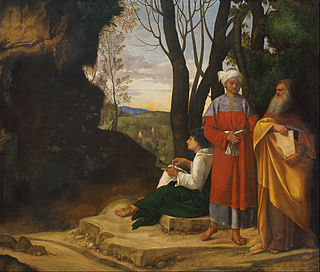 W
WThe Three Philosophers is an oil painting on canvas attributed to the Italian High Renaissance artist Giorgione. It shows three philosophers – one young, one middle-aged, and one old. The work was commissioned by the Venetian noble Taddeo Contarini, a Venetian merchant with an interest in the occult and alchemy. The Three Philosophers was finished one year before the painter died. One of Giorgione’s last paintings, it is now displayed at the Kunsthistorisches Museum in Vienna. The painting was finished by Sebastiano del Piombo.
 W
WThe Triumphs of Caesar are a series of nine large paintings created by the Italian Renaissance artist Andrea Mantegna between 1484 and 1492 for the Gonzaga Ducal Palace, Mantua. They depict a triumphal military parade celebrating the victory of Julius Caesar in the Gallic Wars. Acknowledged from the time of Mantegna as his greatest masterpiece, they remain the most complete pictorial representation of a Roman triumph ever attempted and together they form the world's largest metric area of Italian Renaissance paintings outside Italy. Acquired by Charles I in 1629, they now form part of the Royal Collection at Hampton Court Palace near London, where they occupy a special gallery, with a new continuous frame intended to capture their original setting, mounted into panelling.
 W
WThe Virgin of the Rocks is the name of two paintings by the Italian artist Leonardo da Vinci, of the same subject, with a composition which is identical except for several significant details. The version generally considered the prime version, the earlier of the two, is unrestored and hangs in the Louvre in Paris. The other, which was restored between 2008–2010, hangs in the National Gallery, London. The paintings are both nearly 2 metres high and are painted in oils. Both were originally painted on wooden panels, but the Louvre version has been transferred to canvas.
 W
WThe Wayfarer is a painting by Hieronymus Bosch. It is currently in Museum Boijmans Van Beuningen in Rotterdam. This painting is round and 71.5 cm (28.1 in) in diameter. It is one of the fragments of a partially lost triptych or diptych, which also included the Allegory of Gluttony and Lust, the Ship of Fools and Death and the Miser.